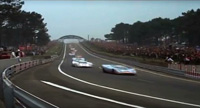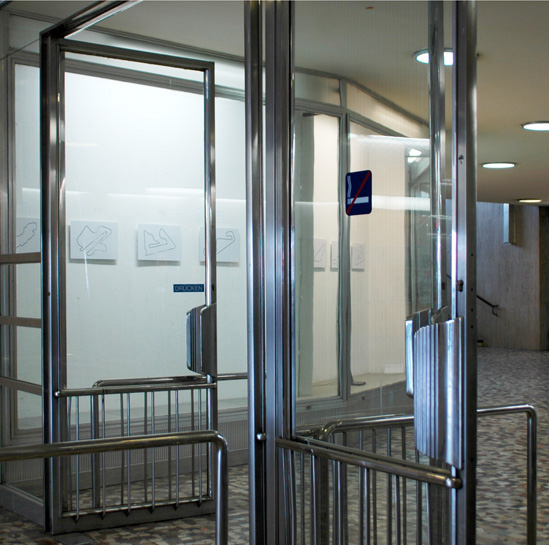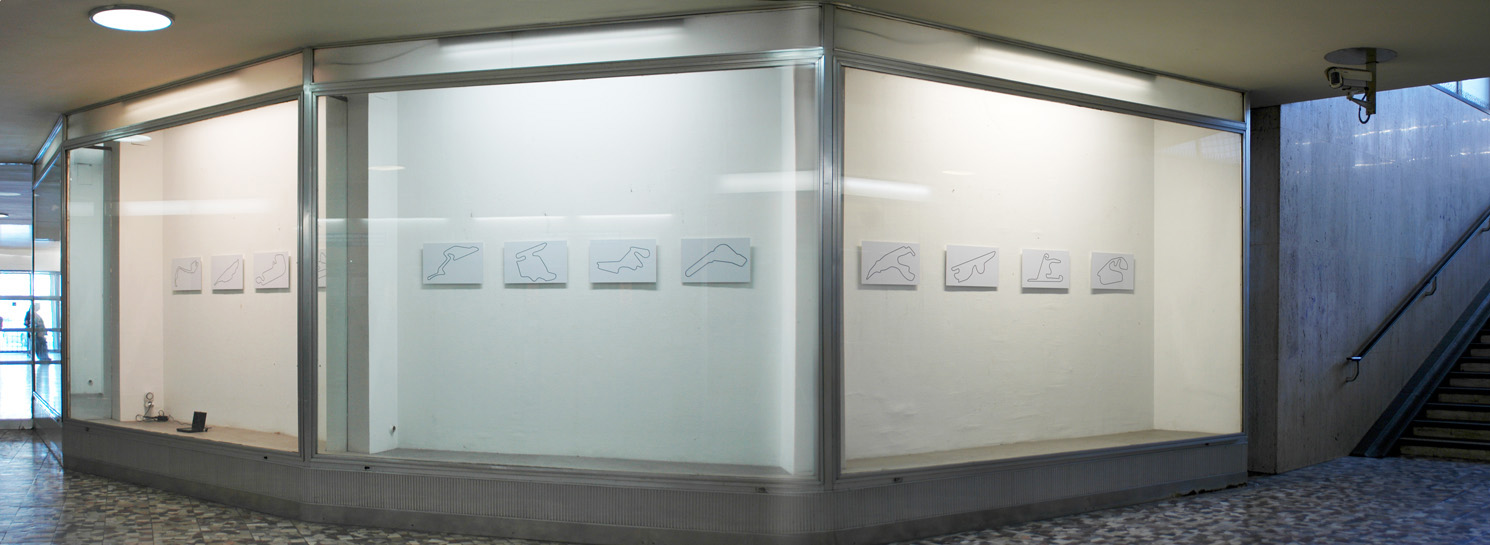title
The Courses 3.1

subtitle
3 times per second / 00' 22''
year
2007 03 10 00:33
material
video
edition
.
seizepx
A 1010x316
px
.
.
exhibitions
2007 03 23 . Entlang . Vienna . Suedbahnhof >
info
footage from the movies
Le Mans . 1971 . Lee H. Katzin >
Riding Giants . 2004 . Stacy Peralta >
sound from the movie THX 1138 . 1971 . George Lucas >
Le Mans . 1971 . Lee H. Katzin >
Riding Giants . 2004 . Stacy Peralta >
sound from the movie THX 1138 . 1971 . George Lucas >
The clip switches between two different sequences 3 times per second
“3 times per second” is not just an experiment in video — it is a critique of media saturation and cognitive fragmentation.
It enacts a digital phenomenology of perception in the attention economy.
By presenting two active, embodied experiences as alternating digital streams, it reflects the way media consumption has replaced physical action with illusionary engagement.
The viewer’s brain thinks it is doing something, but the body remains passive, still, disconnected – a contemporary portrait of attention itself: flickering, divided, unsatisfied.
The video-based project stages an accelerated alternation between two forms of flow: a Formula 1 driver speeding through a race track, and a surfer navigating a wave.
3 times per second, the image shifts from one to the other.
The result is a hypnotic, fractured sequence—one that mimics digital habits of zapping, doomscrolling, and multi-tab viewing.
The project investigates what happens when the brain is caught in a rhythm of visual substitution: not enough time to process, but just enough time to be stimulated.
Rather than a narrative, the work is a neuro-aesthetic loop.
A digital strobe between two extreme physical experiences, mediated entirely through the screen.
The body is absent, yet the illusion of activity remains.
PHILOSOPHICAL aspects
Vilém Flusser wrote about the “technical image” and how media creates a second order of reality. What we perceive is no longer the world, but programmed representations of the world.
In this project, this is taken to an extreme: the brain "sees" action, but the body doesn’t move.
There is no agency—only simulation.
The viewer is not watching to understand the content but to sustain stimulation.
The act of watching becomes programmed, predictable, and passive.
Bernard Stieglers work on the industrialization of attention is highly relevant.
He argues that media technologies increasingly short-circuit deep, meaningful thought by capturing attention through fast, fragmented input.
The 1-second cut rhythm of the video echoes this precisely.
As Stiegler explains, such media consumption leads to a loss of individuation—a person's ability to become themselves—replaced by automatic responses and consumer behaviors.
Jean Baudrillard, described simulation as the replacement of the real by signs of the real.
Watching a race or a wave becomes equivalent in this loop—flattened into exchangeable units of sensory stimulation.
The real effort, danger, and embodiment of these actions are replaced by moving pixels.
“We live in a world where there is more and more information, and less and less meaning.”
The video enacts this digital phenomenology through rhythm, fragmentation, and overstimulation.
Over-saturation leads not to knowledge, but to cognitive noise.”
BIOLOGICAL aspects
Dopaminergic Reward Systems Every switch in the image—especially in high-intensity footage like sports—triggers dopamine micro-releases.
These momentary hits simulate pleasure or engagement, but without any real accomplishment.
The brain thinks it’s doing something, but it’s only reacting.
Disembodied Stimulation vs. Embodied Cognition
In activities like reading or physical action (surfing, racing), cognition is embodied—the body and brain co-create meaning.
In contrast, screen-based visual input creates disembodied cognition.
The brain becomes a passive receptor of light and sound patterns.
As philosopher Alva Noë argues, consciousness is not just in the brain—it is enacted through movement and bodily interaction.
The prefrontal cortex, responsible for sustained attention and decision-making, is underutilized in such fast-switching environments.
The viewer becomes a passive receptor of fragmented content, unable to build a coherent model of either scene.
Mirror neurons, often activated during observed motion, are tricked into partial simulation.
The brain thinks it’s doing something active—surfing, racing—but there is no physical engagement.
This is a false sense of embodiment, like phantom movement.
It’s visual processing without muscular feedback—a disembodied performance loop.
Working memory is bypassed: the flickering is too fast to encode either video meaningfully. This leads to illusory cognitive engagement—the sensation of learning or doing without long-term retention or comprehension.
As seen in studies of multitasking and digital media use, this leads to cognitive fatigue, not knowledge.
This project is a critical media intervention: a looping visual experiment that exposes the illusion of action in digital consumption.
It shows how media creates the sensation of engagement without depth, and how the body is bypassed in favor of pure visual stimulus.
Surfing and racing—once the ultimate expressions of flow and control—are reduced to flickering icons in an attention economy.
The viewer does not surf or race, but merely scans. The loop keeps going.
The brain thinks it’s busy.
It enacts a digital phenomenology of perception in the attention economy.
By presenting two active, embodied experiences as alternating digital streams, it reflects the way media consumption has replaced physical action with illusionary engagement.
The viewer’s brain thinks it is doing something, but the body remains passive, still, disconnected – a contemporary portrait of attention itself: flickering, divided, unsatisfied.
The video-based project stages an accelerated alternation between two forms of flow: a Formula 1 driver speeding through a race track, and a surfer navigating a wave.
3 times per second, the image shifts from one to the other.
The result is a hypnotic, fractured sequence—one that mimics digital habits of zapping, doomscrolling, and multi-tab viewing.
The project investigates what happens when the brain is caught in a rhythm of visual substitution: not enough time to process, but just enough time to be stimulated.
Rather than a narrative, the work is a neuro-aesthetic loop.
A digital strobe between two extreme physical experiences, mediated entirely through the screen.
The body is absent, yet the illusion of activity remains.
PHILOSOPHICAL aspects
Vilém Flusser wrote about the “technical image” and how media creates a second order of reality. What we perceive is no longer the world, but programmed representations of the world.
In this project, this is taken to an extreme: the brain "sees" action, but the body doesn’t move.
There is no agency—only simulation.
The viewer is not watching to understand the content but to sustain stimulation.
The act of watching becomes programmed, predictable, and passive.
Bernard Stieglers work on the industrialization of attention is highly relevant.
He argues that media technologies increasingly short-circuit deep, meaningful thought by capturing attention through fast, fragmented input.
The 1-second cut rhythm of the video echoes this precisely.
As Stiegler explains, such media consumption leads to a loss of individuation—a person's ability to become themselves—replaced by automatic responses and consumer behaviors.
Jean Baudrillard, described simulation as the replacement of the real by signs of the real.
Watching a race or a wave becomes equivalent in this loop—flattened into exchangeable units of sensory stimulation.
The real effort, danger, and embodiment of these actions are replaced by moving pixels.
“We live in a world where there is more and more information, and less and less meaning.”
The video enacts this digital phenomenology through rhythm, fragmentation, and overstimulation.
Over-saturation leads not to knowledge, but to cognitive noise.”
BIOLOGICAL aspects
Dopaminergic Reward Systems Every switch in the image—especially in high-intensity footage like sports—triggers dopamine micro-releases.
These momentary hits simulate pleasure or engagement, but without any real accomplishment.
The brain thinks it’s doing something, but it’s only reacting.
Disembodied Stimulation vs. Embodied Cognition
In activities like reading or physical action (surfing, racing), cognition is embodied—the body and brain co-create meaning.
In contrast, screen-based visual input creates disembodied cognition.
The brain becomes a passive receptor of light and sound patterns.
As philosopher Alva Noë argues, consciousness is not just in the brain—it is enacted through movement and bodily interaction.
The prefrontal cortex, responsible for sustained attention and decision-making, is underutilized in such fast-switching environments.
The viewer becomes a passive receptor of fragmented content, unable to build a coherent model of either scene.
Mirror neurons, often activated during observed motion, are tricked into partial simulation.
The brain thinks it’s doing something active—surfing, racing—but there is no physical engagement.
This is a false sense of embodiment, like phantom movement.
It’s visual processing without muscular feedback—a disembodied performance loop.
Working memory is bypassed: the flickering is too fast to encode either video meaningfully. This leads to illusory cognitive engagement—the sensation of learning or doing without long-term retention or comprehension.
As seen in studies of multitasking and digital media use, this leads to cognitive fatigue, not knowledge.
This project is a critical media intervention: a looping visual experiment that exposes the illusion of action in digital consumption.
It shows how media creates the sensation of engagement without depth, and how the body is bypassed in favor of pure visual stimulus.
Surfing and racing—once the ultimate expressions of flow and control—are reduced to flickering icons in an attention economy.
The viewer does not surf or race, but merely scans. The loop keeps going.
The brain thinks it’s busy.
installation
The Courses1.1 – 1.17
October 6th, 2025

